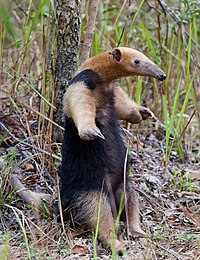Southern tamandua
| Southern tamandua | |
|---|---|
 |
|
| Southern tamandua | |
| Scientific classification | |
| Kingdom: | Animalia |
| Phylum: | Chordata |
| Class: | Mammalia |
| Superorder: | Xenarthra |
| Order: | Pilosa |
| Suborder: | Vermilingua |
| Family: | Myrmecophagidae |
| Genus: | Tamandua |
| Species: | T. tetradactyla |
| Binomial name | |
|
Tamandua tetradactyla (Linnaeus, 1758) |
|
 |
|
| Southern tamandua range | |
| Synonyms | |
|
Myrmecophaga tetradactyla Linnaeus, 1758 |
|
Myrmecophaga tetradactyla Linnaeus, 1758
The southern tamandua (Tamandua tetradactyla), also called the collared anteater or lesser anteater, is a species of anteater from South America. It is a solitary animal, found in many habitats from mature to highly disturbed secondary forests and arid savannas. It feeds on ants, termites, and bees. Its very strong fore claws can be used to break insect nests or to defend itself.
The southern tamandua is found in South America from Venezuela and Trinidad to northern Argentina, southern Brazil, and Uruguay at elevations to 1,600 m (5,200 ft). It inhabits both wet and dry forests, including tropical rainforest, savanna, and thorn scrub. It seems to be most common in habitats near streams and rivers, especially those thick with vines and epiphytes (presumably because its prey is common in these areas).
The oldest fossil tamanduas date from the of South America, although suggests they may have diverged from their closest relative, the giant anteater, in the late Miocene, 12.9 million years ago.
The four recognised subspecies of Tamandua tetradactyla are:
The southern tamandua is a medium-sized anteater, though can vary considerably in size based on environmental conditions. It has a head and body length ranging from 34 to 88 cm (13 to 35 in), and a prehensile tail 37 to 67 cm (15 to 26 in) long. Adults weigh from 1.5 to 8.4 kg (3.3 to 18.5 lb), with no significant difference in size between males and females. Like their close relative, the northern tamanduas, they have four clawed digits on the fore feet and five on the hind feet, and walk on the outer surfaces of their fore feet, to avoid puncturing their palms with their sharp claws. The underside and the tip of the tail are hairless. The snout is long and decurved with an opening only as wide as the diameter of a stick, from which the tongue is protruded. Although some differences in the shape of the skull are seen, they can most easily be distinguished from the northern tamandua by their slightly longer ears, which average around 5 cm (2.0 in), instead of 4 cm (1.6 in) as in the northern species.
...
Wikipedia

